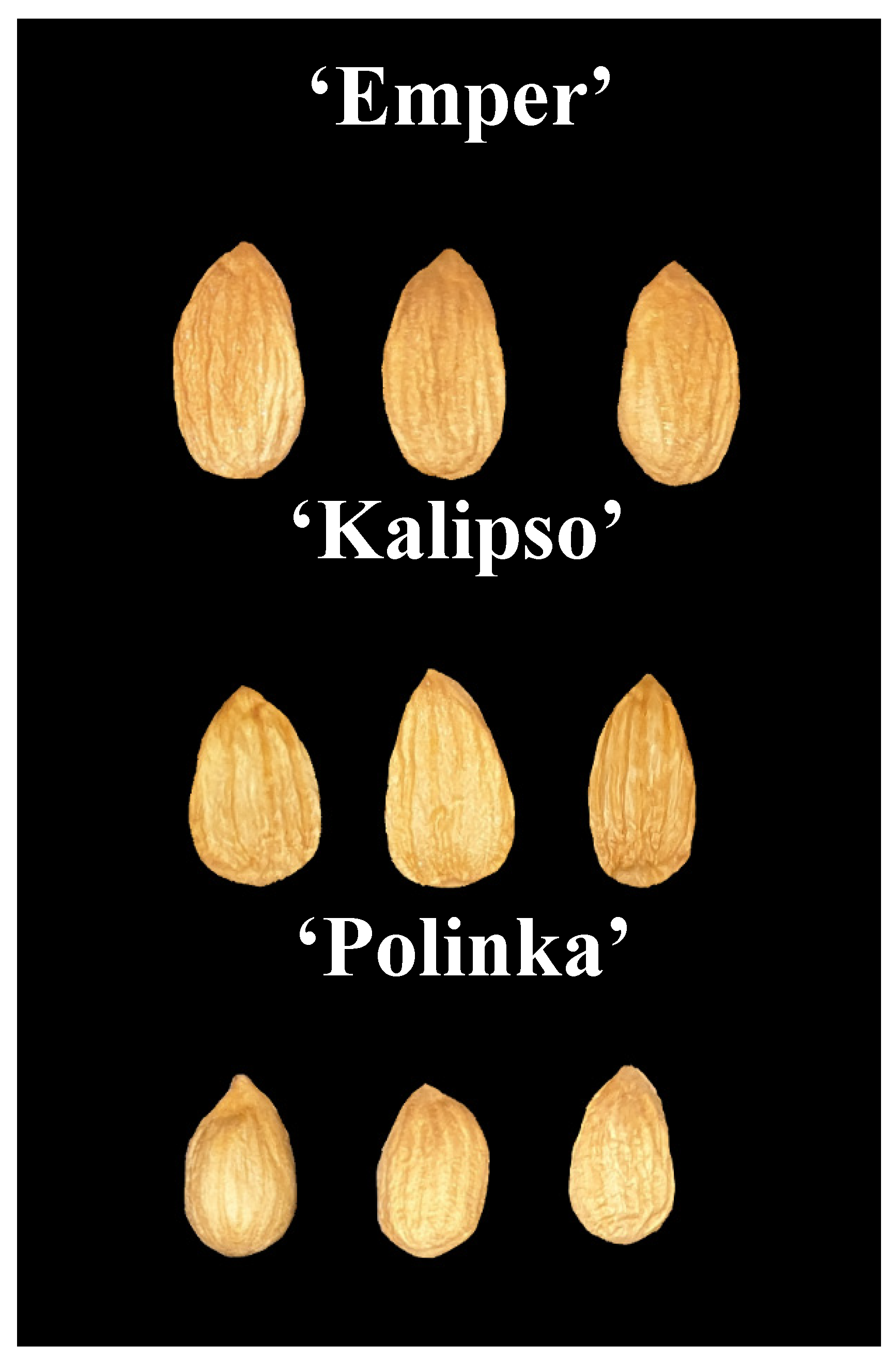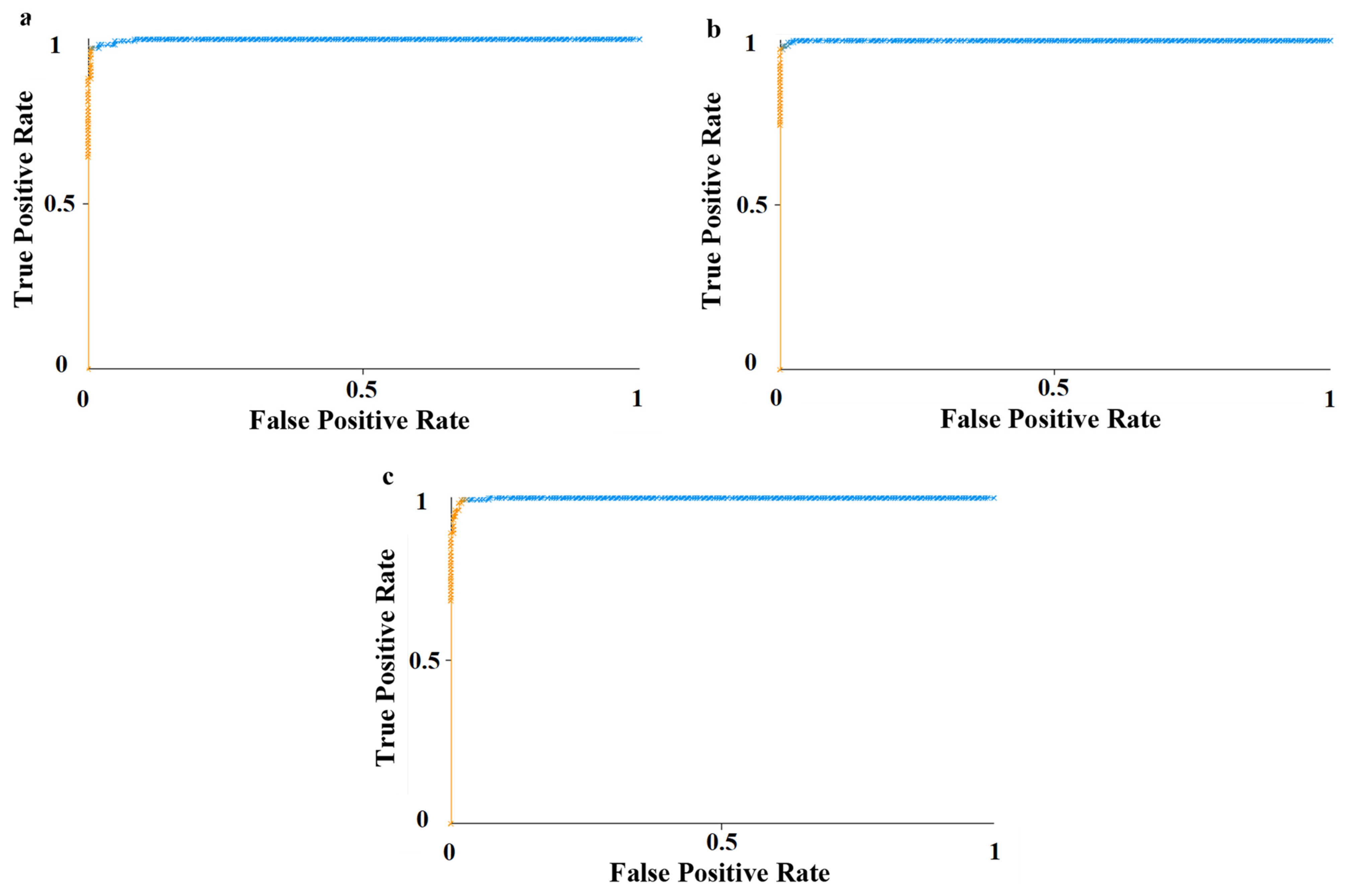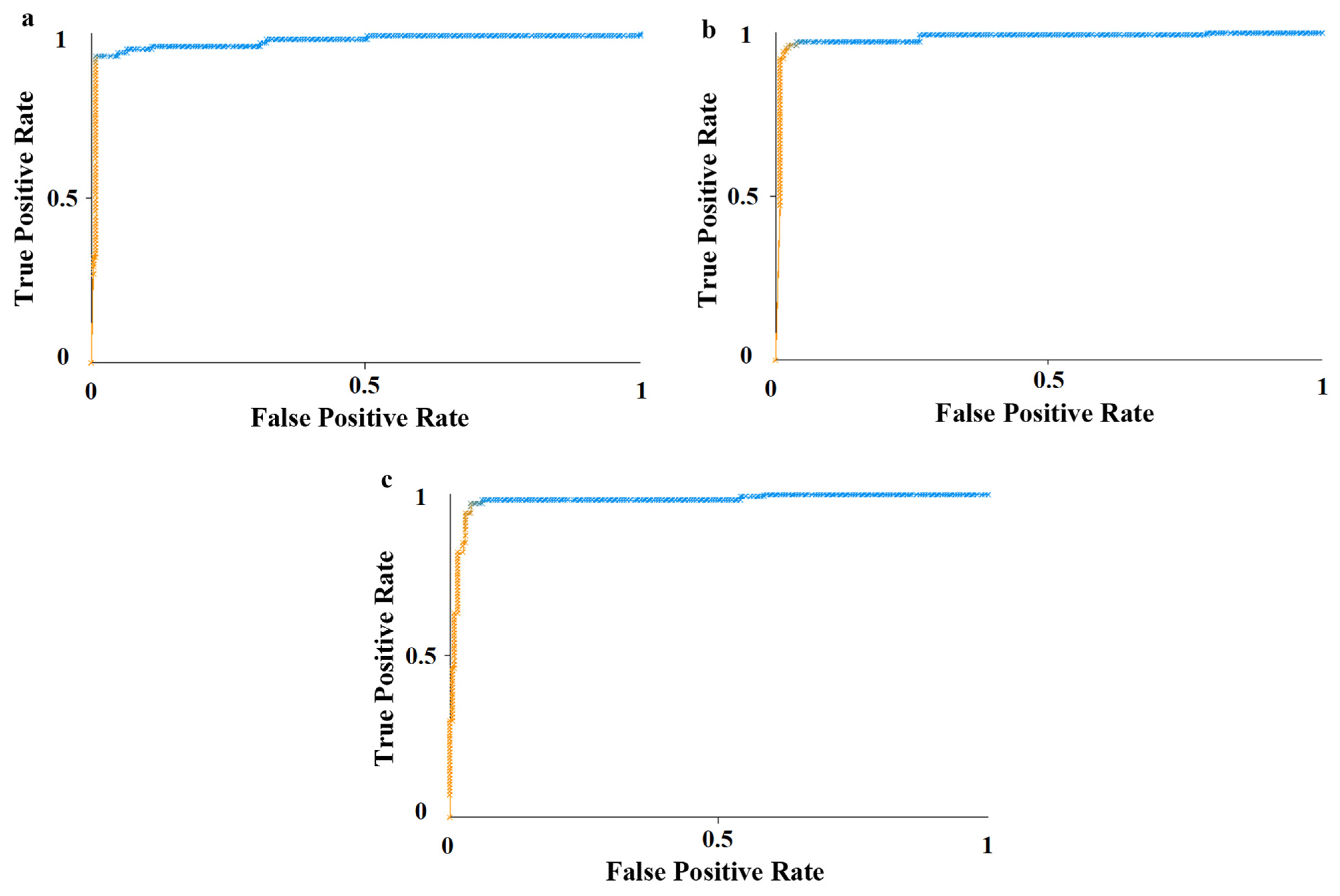Benchmarking Machine Learning Approaches to Evaluate the Cultivar Differentiation of Plum (Prunus domestica L.) Kernels
Abstract
:1. Introduction
2. Materials and Methods
2.1. Materials
2.2. Image Analysis
2.2.1. Image Acquisition
2.2.2. Image Processing
2.3. Discriminant Analysis
2.3.1. Cultivar Discrimination of Plum Kernels
2.3.2. Performance Metrics
- TP:
- True Positive
- TN:
- True Negative
- FP:
- False Positive
- FN:
- False Negative
- TPR:
- True Positive Rate
- FPR:
- False Positive Rate
2.3.3. Machine Learning Algorithms
- -
- KStar—batchSize: 100, debug: False, doNotCheckCapabilities: False, entropicAutoBlend: False, globalBlend: 20,
- -
- PART—batchSize: 100, binarySplits: False, confidenceFactor: 0.25, debug: False, doNotCheckCapabilities: False, minNumObj: 2, numFolds: 3, reducedErrorPruning: False, seed: 1, unpruned: False, useMDLcorrection: False,
- -
- LMT—batchSize: 100, convertNominal: False, debug: False, doNotCheckCapabilities: False, fastRegression: True, minNumInstances: 15, numBoostingIterations: −1, splitOnResiduals: False, useAIC: False, weightTrimBeta: 0.0.
3. Results
4. Discussion
5. Conclusions
Supplementary Materials
Author Contributions
Funding
Institutional Review Board Statement
Informed Consent Statement
Data Availability Statement
Conflicts of Interest
References
- Horvath, A.; Balsemin, E.; Barbot, J.; Christmann, H.; Manzano, G.; Reynet, P.; Laigret, F.; Mariette, S. Phenotypic variability and genetic structure in plum (Prunus domestica L.), cherry plum (P. cerasifera Ehrh.) and sloe (P. spinosa L.). Sci. Hortic. 2011, 129, 283–293. [Google Scholar] [CrossRef]
- Polák, J.; Kundu, J.K.; Krška, B.; Beoni, E.; Komínek, P.; Pívalova, J.; Jarošová, J. Transgenic plum Prunus domestica L., clone C5 (cv. HoneySweet) for protection against sharka disease. J. Integr. Agric. 2017, 16, 516–522. [Google Scholar] [CrossRef] [Green Version]
- Szalay, L.; Molnár, Á.; Kovács, S. Frost hardiness of flower buds of three plum (Prunus domestica L.) cultivars. Sci. Hortic. 2017, 214, 228–232. [Google Scholar] [CrossRef]
- Sheikh, M.A.; Saini, C.S.; Sharma, H.K. Analyzing the effects of hydrothermal treatment on antinutritional factor content of plum kernel grits by using response surface methodology. Appl. Food Biotechnol. 2021, 1, 100010. [Google Scholar] [CrossRef]
- Ali, M.; Cha, J.; Park, S.J.; Akhter, T.; Kim, G.S.; Yang, K.; Seonwoo, H.; Kim, H. Development and performance evaluation of automatic plum seed remover. Eng. Agric. Environ. Food. 2019, 12, 250–255. [Google Scholar] [CrossRef]
- Anwar, F.; Manzoor, M.; Bukhari, I.H.; Aladedunye, F. Physico-chemical attributes of fruit seed oils from different varieties of peach and plum. J. Adv. Biol. 2014, 4, 384–392. [Google Scholar]
- Górnaś, P.; Rudzińska, M.; Raczyk, M.; Mišina, I.; Soliven, A.; Lacis, G.; Segliņa, D. Impact of Species and Variety on Concentrations of Minor Lipophilic Bioactive Compounds in Oils Recovered from Plum Kernels. J. Agric. Food Chem. 2016, 64, 898–905. [Google Scholar] [CrossRef]
- Savic, I.; Gajic, I.S.; Gajic, D. Physico-chemical properties and oxidative stability of fixed oil from plum seeds (Prunus domestica Linn.). Biomolecules 2020, 10, 294. [Google Scholar] [CrossRef] [Green Version]
- Korir, N.K.; Han, J.; Shangguan, L.; Wang, C.; Kayesh, E.; Zhang, Y.; Fang, J. Plant variety and cultivar identification: Advances and prospects. Crit. Rev. Biotechnol. 2013, 33, 1–15. [Google Scholar] [CrossRef]
- Osako, Y.; Yamane, H.; Lin, S.Y.; Chen, P.A.; Tao, R. Cultivar discrimination of litchi fruit images using deep learning. Sci. Hortic. 2020, 269, 10936. [Google Scholar] [CrossRef]
- Ropelewska, E.; Sabanci, K.; Aslan, M.F. Discriminative Power of Geometric Parameters of Different Cultivars of Sour Cherry Pits Determined Using Machine Learning. Agriculture 2021, 11, 1212. [Google Scholar] [CrossRef]
- Zhou, Q.; Huang, W.; Fan, S.; Zhao, F.; Liang, D.; Tian, X. Non-destructive discrimination of the variety of sweet maize seeds based on hyperspectral image coupled with wavelength selection algorithm. Infrared Phys. Technol. 2020, 109, 103418. [Google Scholar] [CrossRef]
- Gulzar, Y.; Hamid, Y.; Soomro, A.B.; Alwan, A.A.; Journaux, L. A Convolution Neural Network-Based Seed Classification System. Symmetry 2020, 12, 2018. [Google Scholar] [CrossRef]
- Javanmardi, S.; Miraei Ashtiani, S.-H.; Verbeek, F.J.; Martynenko, A. Computer-vision classification of corn seed varieties using deep convolutional neural network. J. Stored Prod. Res. 2021, 92, 101800. [Google Scholar] [CrossRef]
- Ropelewska, E. Classification of the pits of different sour cherry cultivars based on the surface textural features. J. Saudi Soc. Agric. Sci. 2020, 20, 52–57. [Google Scholar] [CrossRef]
- Ropelewska, E. The Application of Machine Learning for Cultivar Discrimination of Sweet Cherry Endocarp. Agriculture 2021, 11, 6. [Google Scholar] [CrossRef]
- Ropelewska, E.; Rutkowski, K.P. Differentiation of peach cultivars by image analysis based on the skin, flesh, stone and seed textures. Eur. Food Res. Technol. 2021, 247, 2371–2377. [Google Scholar] [CrossRef]
- Ucchesu, M.; Sarigu, M.; Del Vais, C.; Sanna, I.; d’Hallewin, G.; Grillo, O.; Bacchetta, G. First finds of Prunus domestica L. in Italy from the Phoenician and Punic periods (6th–2nd centuries bc). Veget. Hist. Archaeobot. 2017, 26, 539–549. [Google Scholar] [CrossRef] [Green Version]
- Szczypiński, P.M.; Strzelecki, M.; Materka, A.; Klepaczko, A. MaZda-A software package for image texture analysis. Comput. Methods Programs Biomed. 2009, 94, 66–76. [Google Scholar] [CrossRef]
- Bouckaert, R.R.; Frank, E.; Hall, M.; Kirkby, R.; Reutemann, P.; Seewald, A.; Scuse, D. WEKA Manual for Version 3-9-1; University of Waikato: Hamilton, New Zealand, 2016; pp. 1–341. [Google Scholar]
- Frank, E.; Hall, M.A.; Witten, I.H. The WEKA Workbench. In Online Appendix for Data Mining: Practical Machine Learning Tools and Techniques, Morgan Kaufmann, 4th ed.; Elsevier: San Francisco, CA, USA, 2016; pp. 1–128. [Google Scholar]
- Witten, I.H.; Frank, E. Data mining: Practical Machine Learning Tools and Techniques, 2nd ed.; Elsevier: San Francisco, CA, USA, 2005; pp. 1–558. [Google Scholar]
- Aslan, M.F.; Sabanci, K.; Durdu, A. A CNN-based novel solution for determining the survival status of heart failure patients with clinical record data: Numeric to image. Biomed. Signal Process. Control 2021, 68, 102716. [Google Scholar] [CrossRef]
- Aslan, M.F.; Unlersen, M.F.; Sabanci, K.; Durdu, A. CNN-based transfer learning–BiLSTM network: A novel approach for COVID-19 infection detection. Appl. Soft Comput. 2021, 98, 106912. [Google Scholar] [CrossRef] [PubMed]
- de Medeiros, A.D.; Capobiango, N.P.; da Silva, J.M.; da Silva, L.J.; da Silva, C.B.; dos Santos Dias, D.C.F. Interactive machine learning for soybean seed and seedling quality classification. Sci. Rep. 2020, 10, 11267. [Google Scholar] [CrossRef] [PubMed]
- Rajković, D.; Marjanović Jeromela, A.; Pezo, L.; Lončar, B.; Zanetti, F.; Monti, A.; Kondić Špika, A. Yield and Quality Prediction of Winter Rapeseed—Artificial Neural Network and Random Forest Models. Agronomy 2022, 12, 58. [Google Scholar] [CrossRef]
- Ahmed, M.R.; Yasmin, J.; Park, E.; Kim, G.; Kim, M.S.; Wakholi, C.; Mo, C.; Cho, B.-K. Classification of Watermelon Seeds Using Morphological Patterns of X-ray Imaging: A Comparison of Conventional Machine Learning and Deep Learning. Sensors 2020, 20, 6753. [Google Scholar] [CrossRef]
- Genze, N.; Bharti, R.; Grieb, M.; Schultheiss, S.J.; Grimm, D.G. Accurate machine learning-based germination detection, prediction and quality assessment of three grain crops. Plant Methods 2020, 16, 157. [Google Scholar] [CrossRef]
- de Medeiros, A.D.; Pinheiro, D.T.; Xavier, W.A.; da Silva, L.J.; dos Santos Dias, D.C.F. Quality classification of Jatropha curcas seeds using radiographic images and machine learning. Ind. Crops Prod. 2020, 146, 112162. [Google Scholar] [CrossRef]
- Wei, Y.; Li, X.; Pan, X.; Li, L. Nondestructive Classification of Soybean Seed Varieties by Hyperspectral Imaging and Ensemble Machine Learning Algorithms. Sensors 2020, 20, 6980. [Google Scholar] [CrossRef]
- Gao, T.; Chandran, A.K.N.; Paul, P.; Walia, H.; Yu, H. HyperSeed: An End-to-End Method to Process Hyperspectral Images of Seeds. Sensors 2021, 21, 8184. [Google Scholar] [CrossRef]
- Sharma, M.; Kaushik, P.; Chawade, A. Frontiers in the Solicitation of Machine Learning Approaches in Vegetable Science Research. Sustainability 2021, 13, 8600. [Google Scholar] [CrossRef]




| Set of Selected Textures | Predicted Class (%) | Actual Class | Average Accuracy (%) | Precision | F-Measure | MCC | ROC Area | PRC Area | ||
|---|---|---|---|---|---|---|---|---|---|---|
| ‘Emper’ | ‘Kalipso’ | ‘Polinka’ | ||||||||
| all color channels | 94 | 2 | 4 | ‘Emper’ | 95 | 0.959 | 0.949 | 0.925 | 0.998 | 0.995 |
| 1 | 98 | 1 | ‘Kalipso’ | 0.933 | 0.956 | 0.934 | 0.999 | 0.998 | ||
| 3 | 5 | 92 | ‘Polinka’ | 0.948 | 0.934 | 0.902 | 0.996 | 0.993 | ||
| color space Lab | 97 | 0 | 3 | ‘Emper’ | 98 | 0.980 | 0.975 | 0.962 | 0.998 | 0.996 |
| 1 | 97 | 2 | ‘Kalipso’ | 1.000 | 0.985 | 0.978 | 1.000 | 0.999 | ||
| 1 | 0 | 99 | ‘Polinka’ | 0.952 | 0.971 | 0.956 | 0.998 | 0.997 | ||
| color channel b | 94 | 3 | 3 | ‘Emper’ | 95 | 0.949 | 0.945 | 0.917 | 0.996 | 0.992 |
| 1 | 97 | 2 | ‘Kalipso’ | 0.942 | 0.956 | 0.933 | 0.998 | 0.996 | ||
| 4 | 3 | 93 | ‘Polinka’ | 0.949 | 0.939 | 0.910 | 0.993 | 0.986 | ||
| Set of Selected Textures | Predicted Class (%) | Actual Class | Average Accuracy (%) | Precision | F-Measure | MCC | ROC Area | PRC Area | ||
|---|---|---|---|---|---|---|---|---|---|---|
| ‘Emper’ | ‘Kalipso’ | ‘Polinka’ | ||||||||
| all color channels | 95 | 1 | 4 | ‘Emper’ | 95 | 0.979 | 0.964 | 0.947 | 0.965 | 0.941 |
| 1 | 97 | 2 | ‘Kalipso’ | 0.942 | 0.956 | 0.933 | 0.969 | 0.928 | ||
| 1 | 5 | 94 | ‘Polinka’ | 0.940 | 0.940 | 0.910 | 0.948 | 0.879 | ||
| color space Lab | 87 | 1 | 12 | ‘Emper’ | 88 | 0.870 | 0.870 | 0.805 | 0.943 | 0.912 |
| 4 | 91 | 5 | ‘Kalipso’ | 0.948 | 0.929 | 0.894 | 0.963 | 0.945 | ||
| 9 | 4 | 87 | ‘Polinka’ | 0.837 | 0.853 | 0.778 | 0.935 | 0.845 | ||
| color channel b | 87 | 4 | 9 | ‘Emper’ | 87 | 0.879 | 0.874 | 0.812 | 0.921 | 0.827 |
| 3 | 92 | 5 | ‘Kalipso’ | 0.885 | 0.902 | 0.852 | 0.952 | 0.900 | ||
| 9 | 8 | 83 | ‘Polinka’ | 0.856 | 0.843 | 0.766 | 0.899 | 0.810 | ||
| Set of Selected Textures | Predicted Class (%) | Actual Class | Average Accuracy (%) | Precision | F-Measure | MCC | ROC Area | PRC Area | ||
|---|---|---|---|---|---|---|---|---|---|---|
| ‘Emper’ | ‘Kalipso’ | ‘Polinka’ | ||||||||
| all color channels | 92 | 3 | 5 | ‘Emper’ | 95 | 0.979 | 0.948 | 0.925 | 0.969 | 0.945 |
| 1 | 96 | 3 | ‘Kalipso’ | 0.941 | 0.950 | 0.925 | 0.979 | 0.953 | ||
| 1 | 3 | 96 | ‘Polinka’ | 0.923 | 0.941 | 0.911 | 0.978 | 0.961 | ||
| color space Lab | 92 | 1 | 7 | ‘Emper’ | 94 | 0.948 | 0.934 | 0.902 | 0.975 | 0.969 |
| 3 | 94 | 3 | ‘Kalipso’ | 0.979 | 0.959 | 0.940 | 0.985 | 0.979 | ||
| 2 | 1 | 97 | ‘Polinka’ | 0.907 | 0.937 | 0.905 | 0.968 | 0.896 | ||
| color channel b | 94 | 1 | 5 | ‘Emper’ | 92 | 0.940 | 0.940 | 0.910 | 0.977 | 0.969 |
| 3 | 90 | 7 | ‘Kalipso’ | 0.938 | 0.918 | 0.879 | 0.985 | 0.978 | ||
| 3 | 5 | 92 | ‘Polinka’ | 0.885 | 0.902 | 0.852 | 0.971 | 0.899 | ||
Publisher’s Note: MDPI stays neutral with regard to jurisdictional claims in published maps and institutional affiliations. |
© 2022 by the authors. Licensee MDPI, Basel, Switzerland. This article is an open access article distributed under the terms and conditions of the Creative Commons Attribution (CC BY) license (https://creativecommons.org/licenses/by/4.0/).
Share and Cite
Ropelewska, E.; Cai, X.; Zhang, Z.; Sabanci, K.; Aslan, M.F. Benchmarking Machine Learning Approaches to Evaluate the Cultivar Differentiation of Plum (Prunus domestica L.) Kernels. Agriculture 2022, 12, 285. https://doi.org/10.3390/agriculture12020285
Ropelewska E, Cai X, Zhang Z, Sabanci K, Aslan MF. Benchmarking Machine Learning Approaches to Evaluate the Cultivar Differentiation of Plum (Prunus domestica L.) Kernels. Agriculture. 2022; 12(2):285. https://doi.org/10.3390/agriculture12020285
Chicago/Turabian StyleRopelewska, Ewa, Xiang Cai, Zhan Zhang, Kadir Sabanci, and Muhammet Fatih Aslan. 2022. "Benchmarking Machine Learning Approaches to Evaluate the Cultivar Differentiation of Plum (Prunus domestica L.) Kernels" Agriculture 12, no. 2: 285. https://doi.org/10.3390/agriculture12020285
APA StyleRopelewska, E., Cai, X., Zhang, Z., Sabanci, K., & Aslan, M. F. (2022). Benchmarking Machine Learning Approaches to Evaluate the Cultivar Differentiation of Plum (Prunus domestica L.) Kernels. Agriculture, 12(2), 285. https://doi.org/10.3390/agriculture12020285









